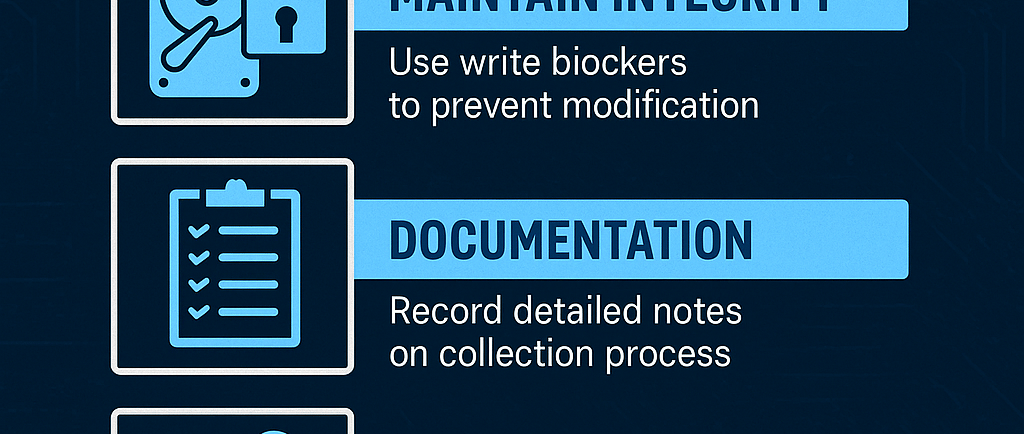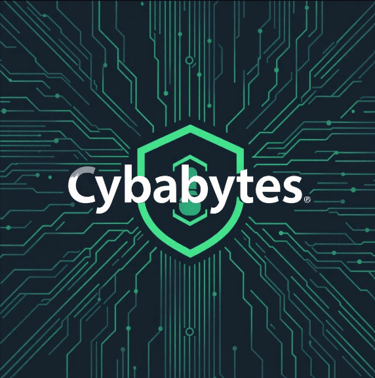Digital Evidence Handling Best Practices
Unlock the essential principles behind effective digital evidence handling. This post breaks down the foundational rules—integrity, authenticity, chain of custody, confidentiality, admissibility, and preservation—that ensure digital evidence remains reliable, secure, and legally defensible in any investigation or courtroom setting. Perfect for professionals and anyone interested in digital forensics.
DFIR
8/1/20253 min read


Introduction
With digital evidence playing a critical role in legal and corporate investigations, ensuring its integrity, authenticity, and admissibility is essential. Mishandling digital evidence—even inadvertently—can make it inadmissible or render investigations incomplete. Below is a comprehensive guide outlining current best practices for collecting, preserving, managing, and presenting digital evidence in 2025.
1. Principles of Digital Evidence Handling
Integrity: Evidence must remain intact—unaltered from the point of collection to court presentation.
Authenticity: The evidence must be proven to be what it purports to be.
Confidentiality: Only authorized personnel should access or handle evidence.
Admissibility: Procedures must align with legal and regulatory standards to ensure acceptance in court
2. The Digital Evidence Lifecycle
3. Best Practices for Collecting Digital Evidence
Scene Preservation: Secure the area to prevent tampering. Place devices in Faraday bags to block remote wipes or network access
Comprehensive Documentation: Photograph devices as found, document their locations, condition, visible activity, and all steps taken during collection
Power Management:
If a device is on, keep it powered to preserve volatile data unless instructed otherwise.
If off, do not turn it on—boot processes may alter evidence.
Network Isolation: Enable airplane mode on mobile devices, or disconnect from Wi-Fi/Ethernet, to prevent unauthorized access or tampering
Physical Safety: Handle devices with gloves and store in anti-static bags, safeguarding from magnets, extreme heat/cold, or liquids
4. Preserving Evidence Integrity
Write Protection: Always use hardware write-blockers when copying storage media, preventing accidental evidence modification
Forensic Imaging:
Create a bit-by-bit copy of storage devices.
Perform all analysis on forensic images, preserving the original device unaltered
Hashing:
Generate cryptographic hash values (e.g., SHA-256) for original media and forensic images to prove data has not changed
5. Chain of Custody
Definition: The complete, chronological record documenting each person who handled evidence, what was done, and when.
Importance: Breaks or gaps can lead to evidence being ruled inadmissible
Best Practice Steps:
Assign a dedicated evidence custodian
Use tamper-evident packaging and seals for transporting/holding evidence
Log every movement and action with timestamps and personnel details.
Employ both paper and digital chain of custody forms for redundancy and clarity
Include evidence identifiers (serial numbers, device details) for precise tracking
.
6. Secure Storage & Access Control
Physical Storage: Store digital devices in locked, climate-controlled environments, away from electromagnetic interference or unauthorized personnel
Digital Security:
Encrypt evidence stored in digital repositories.
Use role-based access controls and audit logging for optimal security.
Maintain redundant backups in secure, separate locations
7. Handling & Analysis
Use Forensic-grade Tools: Only employ validated and legally recognized forensic software and hardware for examination
Work on Copies: All investigative work must be performed on forensic images, never on originals.
Record Every Action: Log every interaction, analysis step, and result in forensic notes. Any change—even minor—should be justified and recorded
8. Legal & Regulatory Compliance
Collect, store, and analyze digital evidence in accordance with local, national, and international laws and regulations (e.g., CJIS, GDPR, Federal Rules of Evidence).
Obtain and document appropriate legal authority (warrants, consent, etc.) prior to evidence acquisition
9. Centralized Management Systems
Employ digital evidence management systems that:
Centralize all digital evidence types.
Automate chain of custody records.
Provide tamper-evident storage and audit trails
Integrate with case management and compliance reporting tools.
10. Regular Training & Review
Continually train staff in new threats, technologies, and evolving best practices.
Conduct mock exercises and routine audits to test protocols and readiness
Common Pitfalls to Avoid
Failing to secure and isolate evidence early.
Working directly on original media instead of forensic copies.
Gaps or errors in chain of custody logs.
Poor documentation or insufficient metadata capture.
Neglecting to update procedures as technology and the legal landscape evolve
Conclusion
By rigorously applying established best practices—scene preservation, meticulous documentation, secure storage, and unbroken chain of custody—organizations and investigators maintain the evidentiary value and legal admissibility of digital evidence. As technology changes, so must procedures and vigilance to ensure digital investigations uphold the highest professional and legal standards.
